-
Spring Planting
Order now for best selections.
-
Fall Planting
Available for preorder for fall 2025 delivery.
-
Bulk Flower Bulbs
Big savings on bulk orders!
- New
-
Gardening Resources
Flower Bulbs & Perennials at Wholesale Prices

How To Plant, Grow and Care For Dahlias
| Botanical Name | Dahlia |
| Plant Type | Tubers |
| Sun Exposure | Full sun |
| Soil Type | Well-drained acidic, clay, loamy or sandy soils |
| Soil pH | Slightly acidic |
| Bloom Time | Midsummer to early fall |
| Flower Color | Purple, white, yellow, pink, red, orange, bicolor |
| Hardiness Zones | 3, 4, 5, 6, 7, 8, 9, 10 (lift in zones 3-8) |
| Special Features | Available in hundreds of varieties, most dahlias make spectacular cut flowers. |
First-time dahlia growers are amazed that such elegant and showy flowers are so easy to grow. With dahlias, it's all about the flower—its form, size and color. Available in hundreds of varieties, they can range in size from a few inches to up to a foot across! Some have fringy, fanciful petals, while others are classic, ball shaped. And, there are so many colors to choose from, too. They're one of the top flowers for cut-flower displays in the summer and into fall.
Native to Central and South America, dahlias are grown from tubers and perform best in full sun. Their flowers often symbolize kindness and elegance. Once gardeners start growing dahlias, they often try more and more different varieties in the coming years.
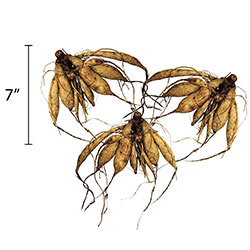
How to Plant Dahlia Tubers
When planting dahlia tubers outdoors, wait until all danger of frost has passed. Dig the soil to a depth of 12" and mix in peat moss or compost. Replace about half of the soil and then place the tubers flat. Cover with remaining soil. Tubers should be spaced 12-36" apart, depending on the variety. Using an all-natural, slow-release fertilizer, like Van Bourgondien 100% Natural Bulb Food, can also give dahlias a boost. Water immediate after planting, and then don't water again until shoots appear. For taller varieties, you'll also need stakes.
If starting dahlias indoors, plant dahlia tubers in individual pots with damp peat moss and vermiculite. Care must be taken when transplanting them outdoors.
Planting Dahlias in Pots and Containers
Plant one dahlia tuber in a 6-8" pot. Use a soil mixture of equal parts potting soil, sand and peat moss. Good drainage is essential. Plant with the crown slightly above the soil surface. The soil surface should be at least 1⁄2 to 1" below the pot rim. Do not divide roots prior to planting. After planting, water well and continue to keep the soil moist but not wet.Fertilizer should be applied as soon as the foliage begins to appear. Slow-release fertilizer (14-14-14) is recommended. When the flower buds appear, water may have to be increased due to the increased demand of the plant for water while developing buds. Do not wet the plant foliage when watering.
When to Plant Dahlia Tubers
Dahlias are tender perennials that are planted in the late spring, after all danger of frost has passed. Northern gardeners often start dahlia tubers indoors about 4 weeks before the last spring frost date and then transplant them outdoors when temperatures warm. If you plan to grow dahlias, order dahlia tubers in late winter to early spring for the best selection. Oftentimes, popular varieties sell out quickly.
Where to Plant Dahlias
Dahlias can be grown in zones 3-10. However, they are only hardy, or able to stay in the ground over winter, in zones 9-10. In zones 3-8, dahlia tubers must be dug up or lifted in the fall. You can find your grow zone using our zone finder.
Dahlias grow best in full sun. While they can be grown in partial shade, they don't flower as well. Dahlias also perform best in well-drained, slightly acidic soil. If you are growing taller dahlias or Dinnerplate dahlias, they should be staked. Placing the stakes is best done at planting time.
How to Grow Dahlias
Once shoots appear, dahlias need about 1" of rainfall weekly.
For larger flowers, pinch and disbud the side buds so that the central bloom can develop. Removing spent flower stems encourages new growth and a fuller appearance.
In areas with winter freeze, carefully dig the tubers in fall after the frost kills the foliage. Cut the stalk approximately 3" above the tuber. Dahlias should be dried for only a couple of hours before storing in plastic-lined shallow boxes with a blanket of vermiculite or peat moss. Store in a dry place that's about 40-45 degrees.
Dahlia FAQs
What Insects Bother Dahlias?
Common insect pests include aphids, caterpillars, slugs, spider mites and leafhoppers. Inspect your dahlia plants frequently for signs of pest damage.What Diseases Bother Dahlias?
Dahlias can suffer from plant diseases such as viruses, root rot and powdery mildew. Planting your dahlias in well-drained soil and full sun and avoiding overcrowding may reduce some disease pressure.What are Dahlia Harvesting Tips?
Dahlia flowers often last about a week in the vase. To harvest dahlia flowers, cut the stems in the morning, remove the bottom leaves and place them in cool water. The more you cut, the more they bloom.Do Dahlias Come Back Every Year?
In zones 9-10, dahlias can be left in the ground over winter and come back year after year. In zones 3-8, the tubers are lifted in the fall, stored indoors over winter and replanted in late spring.How Tall do Dahlias Grow?
Depending on the variety, dahlias can grow 15-60" tall.Are Dahlias Perennials or Annuals?
Dahlias are tender perennials. They can overwinter in the ground in zones 9-10. In zones 3-8, they can be grown as annuals or dug up in the fall.How to Deadhead Dahlias
When the flowers begin to wilt, pinch off the stem just below the flower head.How Long do Dahlias Bloom?
Dahlias bloom from midsummer to the first fall frost.Do Dahlias Bloom all Summer?
Dahlias will bloom all summer. Deadheading and cutting the flowers encourages more blooms.Types of Dahlias
Dahlia flowers come in a wide range of colors and forms. For more information, read our types of dahlia flowers guide.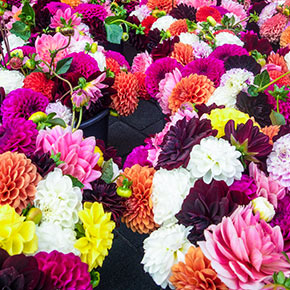
Decorative Dahlias: Available in a wide range of flower forms, Decorative Dahlias fit a variety of gardening styles and color schemes. Flower form can range from single and double, to ball and cactus types. Their size, too, can vary from a few inches to several inches across.
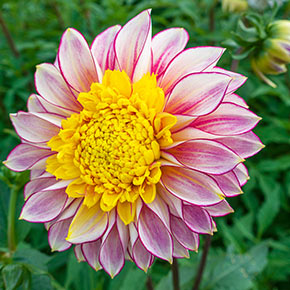
Powder-Puff Dahlias: Some of the most distinctive flowers available, Powder-Puff or Anemone dahlias have a captivating form. A ring of large ray florets circle a central disc comprised of small disc florets.

Single-Flowering Dahlias: Often a favorite of pollinators, Single Flowered dahlias comprise a solitary row of either flat or slightly recurved ray florets surrounding a central disc. These dahlia flowers are 2-5 inches wide and feature eye-catchy single or bicolor patterns.
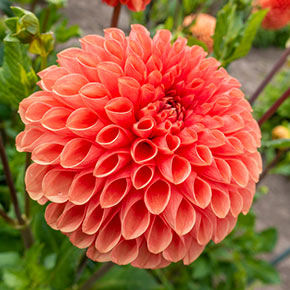
Ball Dahlias: Unique, orb-shaped blooms make Ball dahlias a favorite in the garden or the vase. Giant Ball dahlias measure up to 5 ½" across and give mass plantings a distinctive polka dot effect.

Dinnerplate Dahlias: When gardeners mention dahlias, these often come to mind. The huge blooms reach 6-10 inches across—and a single flower can fill a vase. Because of their flower size, Dinnerplate dahlias often require staking.
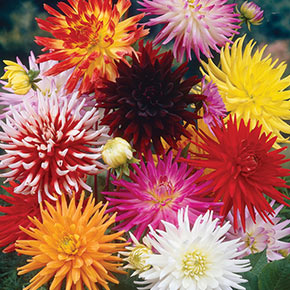
Cactus Dahlias: Featuring tightly rolled petals, Cactus dahlias look like they have "spikes." Available in an array of colors, they add plenty of pizzazz to summer landscapes and cut-flower displays.
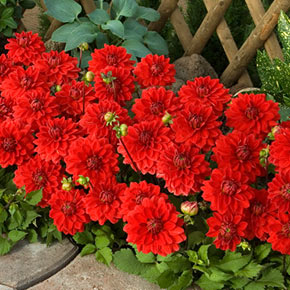
Other Dahlias: There are lots of other dahlias to consider. If growing flowers for cut flowers, consider Karma dahlias that were specifically developed for the cut-flower market. Patio and Border dahlias are lower growing dahlias.
| Shop All Flower Bulbs | |
| See More Tips |
Have another question? Return to the Customer Service Help page or send an e-mail directly to Customer Service
Copyright © 2025 Gardens Alive!, Inc. d/b/a Dutchbulbs.com. All Rights Reserved. Dutchbulbs.com trademarks are registered trademarks of Gardens Alive!, Inc.
This site is protected by reCAPTCHA and Google Privacy Policy and Terms apply.
This site is protected by reCAPTCHA and Google Privacy Policy and Terms apply.

Item added to cart





